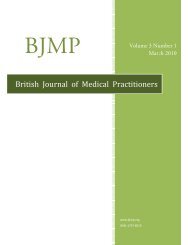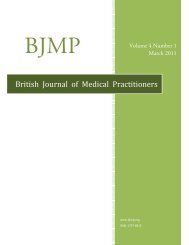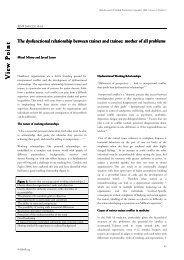R esearch A rticle - British Journal of Medical Practitioners
R esearch A rticle - British Journal of Medical Practitioners
R esearch A rticle - British Journal of Medical Practitioners
Create successful ePaper yourself
Turn your PDF publications into a flip-book with our unique Google optimized e-Paper software.
<strong>British</strong> <strong>Journal</strong> <strong>of</strong> <strong>Medical</strong> <strong>Practitioners</strong>, March 2013, Volume 6, Number 1<br />
Table 1: Causes <strong>of</strong> Spinal Cord Injury<br />
patients underwent laparotomy. There was one (5.2%) fatality<br />
Cause <strong>of</strong> Injury<br />
Number<br />
Percentage<br />
reported.<br />
Fall from stairs 6<br />
Road traffic accidents 5<br />
Fall from height 4<br />
Rugby injury 1<br />
Cycling accident 1<br />
Old injury admitted with skin problem 1<br />
Post surgical abscess 1<br />
31.5%<br />
26.3%<br />
21%<br />
5.2%<br />
5.2%<br />
5.2%<br />
5.2%<br />
Table 3: Previous Risk Factors in Spinal Cord Injured Patients<br />
with Stress Ulcers<br />
Adverse Factor<br />
Number <strong>of</strong> Patients with the Problem<br />
Smoking 13 (68.4%)<br />
Alcohol 5 (26.3%)<br />
Reflux Oesophagitis 4 (21%)<br />
Hypertension 3 (15.8%)<br />
The American Spinal Injury Association (ASIA) impairment<br />
scales <strong>of</strong> all 19 patients are shown in Table 2. Associated<br />
injuries were encountered in 4 (21%) <strong>of</strong> patients. These<br />
associated injuries include sternum fracture, rib fractures,<br />
clavicle fracture, tendon injury and a calcaneum fracture.<br />
Significant past medical history was found in 14 (73.6%)<br />
patients whereas 5 (26.4%) did not have any previous medical<br />
illness. The list <strong>of</strong> all the significant past medical problems is<br />
shown in Table 3.<br />
Diabetes Mellitus 3 (15.8%)<br />
Hiatus Hernia 2 (10.5%)<br />
Ischemic Heart Disease 2 (10.5%)<br />
Asthma 1 (5.3%)<br />
Duodenal Ulcers 1 (5.3%)<br />
Anaemia 1 (5.3%)<br />
Pyloric Stenosis 1 (5.3%)<br />
Table 4: Endoscopic Findings, Procedures and Outcome<br />
Table 2: American Spinal Injury Association Impairment Scale<br />
ASIA Impairment Scale<br />
A= Complete: No motor or sensory function is<br />
preserved in the sacral segments S4-S5.<br />
B=Incomplete: Sensory but not motor function is<br />
preserved below the neurological level and<br />
includes the sacral segments S4-S5<br />
C=Incomplete: Motor function is preserved below<br />
the neurological level, and more than half <strong>of</strong> key<br />
10<br />
muscles below the neurological level have a muscle<br />
grade less than 3<br />
D=Incomplete: Motor function is preserved below<br />
the neurological level, and at least half <strong>of</strong> key<br />
2<br />
muscles below the neurological level have a muscle<br />
grade <strong>of</strong> 3 or more<br />
E=Normal: motor and sensory function are<br />
normal<br />
Number Percentage<br />
3<br />
1<br />
3<br />
15.7%<br />
5.2%<br />
52.6%<br />
10.5%<br />
15.7%<br />
Number<br />
2<br />
1<br />
1<br />
1<br />
1<br />
2<br />
Endoscopic findings, Procedures and Outcome<br />
Bleeding Duodenal Ulcer injected with adrenaline Bleeding<br />
stopped<br />
Had Endoscopy twice and bleeding Duodenal Ulcer<br />
injected with adrenaline on both occasions Continuous<br />
bleeding Underwent Laparotomy and over Sewing <strong>of</strong> the<br />
ulcer<br />
Endoscopic findings ings were Oesophagitis, Hiatus Hernia and<br />
superficial ulcerations No procedure performed Treated<br />
Conservatively<br />
Bleeding Duodenal Ulcer injected with adrenaline<br />
Continuous bleeding Prepared for Laparotomy but could<br />
not survive<br />
Bleeding Duodenal Ulcer injected with adrenaline Bleeding<br />
stopped Barrett’s oesophagus was found and biopsied but<br />
biopsy results were negative<br />
Bleeding Duodenal Ulcer injected with adrenaline<br />
Continuous bleeding Laparotomy and over sewing<br />
4 (21%) patients were already taking Omeprazole before<br />
admission, whereas 2 (10.5%) were taking Ranitidine and 1<br />
(5.2%) patient was taking Lansoprazole.<br />
Figure 1: Packed Red Cells and Fresh frozen Plasma<br />
Transfusion Units Patients<br />
7 out <strong>of</strong> 19 patients (36.8%) had either one or two episodes <strong>of</strong><br />
significant c<strong>of</strong>fee ground vomiting, 6 (31.5%) patients had an<br />
episode <strong>of</strong> haematemesis and 4 (21%) patients had combined<br />
c<strong>of</strong>fee ground vomiting and haematemesis. Two (10.5%)<br />
patients had positive nasogastric aspirate for bleeding.<br />
All 19 patients were started on intravenous Omeprazole and<br />
Sucralfate was added in 13 patients. Low molecular weight<br />
heparin, Ibupr<strong>of</strong>en and Aspirin was discontinued in all patients.<br />
Six (31.5%) patients were transfused 40 units <strong>of</strong> fresh frozen<br />
plasma and packed red cells (Figure 1). Eight patients (42.1%)<br />
underwent endoscopic treatment (Table 4) and 3 (15.7%)<br />
39







